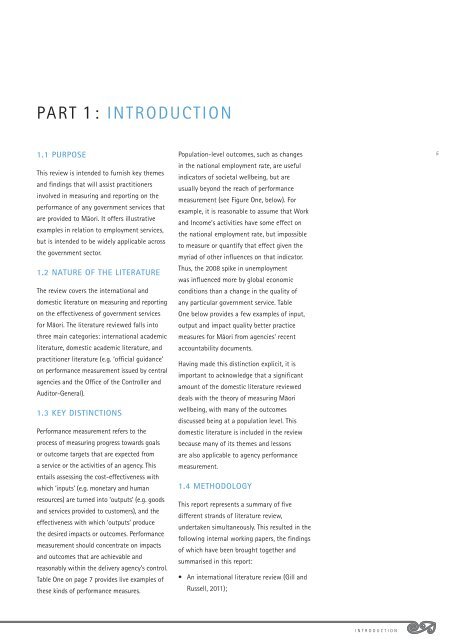Measuring performance and effectiveness for Mäori ... - Te Puni Kokiri
Measuring performance and effectiveness for Mäori ... - Te Puni Kokiri
Measuring performance and effectiveness for Mäori ... - Te Puni Kokiri
Create successful ePaper yourself
Turn your PDF publications into a flip-book with our unique Google optimized e-Paper software.
PART 1 : INTRODUCTION<br />
1.1 PURPOSE<br />
This review is intended to furnish key themes<br />
<strong>and</strong> findings that will assist practitioners<br />
involved in measuring <strong>and</strong> reporting on the<br />
<strong>per<strong>for</strong>mance</strong> of any government services that<br />
are provided to Mäori. It offers illustrative<br />
examples in relation to employment services,<br />
but is intended to be widely applicable across<br />
the government sector.<br />
1.2 NATURE OF THE LITERATURE<br />
The review covers the international <strong>and</strong><br />
domestic literature on measuring <strong>and</strong> reporting<br />
on the <strong>effectiveness</strong> of government services<br />
<strong>for</strong> Mäori. The literature reviewed falls into<br />
three main categories: international academic<br />
literature, domestic academic literature, <strong>and</strong><br />
practitioner literature (e.g. ‘official guidance’<br />
on <strong>per<strong>for</strong>mance</strong> measurement issued by central<br />
agencies <strong>and</strong> the Office of the Controller <strong>and</strong><br />
Auditor-General).<br />
1.3 KEY DISTINCTIONS<br />
Per<strong>for</strong>mance measurement refers to the<br />
process of measuring progress towards goals<br />
or outcome targets that are expected from<br />
a service or the activities of an agency. This<br />
entails assessing the cost-<strong>effectiveness</strong> with<br />
which ‘inputs’ (e.g. monetary <strong>and</strong> human<br />
resources) are turned into ‘outputs’ (e.g. goods<br />
<strong>and</strong> services provided to customers), <strong>and</strong> the<br />
<strong>effectiveness</strong> with which ‘outputs’ produce<br />
the desired impacts or outcomes. Per<strong>for</strong>mance<br />
measurement should concentrate on impacts<br />
<strong>and</strong> outcomes that are achievable <strong>and</strong><br />
reasonably within the delivery agency’s control.<br />
Table One on page 7 provides live examples of<br />
these kinds of <strong>per<strong>for</strong>mance</strong> measures.<br />
Population-level outcomes, such as changes<br />
in the national employment rate, are useful<br />
indicators of societal wellbeing, but are<br />
usually beyond the reach of <strong>per<strong>for</strong>mance</strong><br />
measurement (see Figure One, below). For<br />
example, it is reasonable to assume that Work<br />
<strong>and</strong> Income’s activities have some effect on<br />
the national employment rate, but impossible<br />
to measure or quantify that effect given the<br />
myriad of other influences on that indicator.<br />
Thus, the 2008 spike in unemployment<br />
was influenced more by global economic<br />
conditions than a change in the quality of<br />
any particular government service. Table<br />
One below provides a few examples of input,<br />
output <strong>and</strong> impact quality better practice<br />
measures <strong>for</strong> Mäori from agencies' recent<br />
accountability documents.<br />
Having made this distinction explicit, it is<br />
important to acknowledge that a significant<br />
amount of the domestic literature reviewed<br />
deals with the theory of measuring Mäori<br />
wellbeing, with many of the outcomes<br />
discussed being at a population level. This<br />
domestic literature is included in the review<br />
because many of its themes <strong>and</strong> lessons<br />
are also applicable to agency <strong>per<strong>for</strong>mance</strong><br />
measurement.<br />
1.4 METHODOLOGY<br />
This report represents a summary of five<br />
different str<strong>and</strong>s of literature review,<br />
undertaken simultaneously. This resulted in the<br />
following internal working papers, the findings<br />
of which have been brought together <strong>and</strong><br />
summarised in this report:<br />
• An international literature review (Gill <strong>and</strong><br />
Russell, 2011);<br />
5<br />
I N T R O D U C T I O N

















